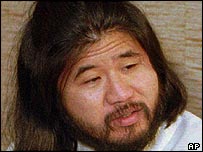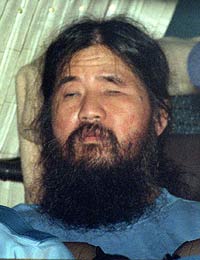Lee Boyd Malvo, the teenager known as the D.C. sniper is now on trial for murder.
At 17 he and his mentor/father figure John Muhammad went on a killing spree that left ten dead in its wake and terrified a nation.
Now 18 Malvo is literally fighting for his own life in a Virginia courtroom. His attorney’s hope that an “insanity” defense based upon a “brainwashing” claim will explain the boy killer’s behavior and somehow ameliorate the outcome of the trial.
John Allen Muhammad the man that allegedly “brainwashed” Malvo has already been convicted and is almost certain to receive the death penalty. If his surrogate son and accomplice is found guilty, it is likely that he will receive the same sentence.
Opinions in the press vary, but some are calling the “insanity defense” in this case “crazy” reports Slate.
And the Washington Post points out those witnesses, who observed Muhammad and Malvo together, differ in their assessment of the relationship.
Some see Muhammad as a controlling and dominant figure that molded the boy into a “killing machine.”
Others say the two appeared more like friends, without readily seen evidence of a dominant/submissive relationship.
Malvo’s taped confession is chilling. The teenager admits, “I intended to kill them all.” And when asked if he personally pulled the trigger in the shootings the boy answers, “In all of them” reports Associated Press.
With such testimony, not to mention the physical evidence piled up by the prosecution, Malvo really has no other meaningful option than to plead insanity.
But was the boy “brainwashed” by John Muhammad or is this some clever lawyer’s contrived defense?
The “brainwashing” defense did not work for Patty Hearst, who was kidnapped by a political cult in the 1970s.
Hearst an heir to a newspaper fortune was coerced into becoming the pawn of the Symbionese Liberation Army (SLA), but was nevertheless ultimately convicted of bank robbery and sentenced to prison.
President Jimmy Carter later commuted her sentence and Bill Clinton pardoned Hearst before leaving the White House.
Public awareness regarding “brainwashing” has evolved considerably since the Manson murders in 1969 and Patty Hearst’s conviction during 1976.
The Jonestown mass suicide/murder of 1978, which claimed the lives of almost 1,000 followers of cult leader Jim Jones in the jungles of South America, shocked the public and created an acute awareness of the power of coercive persuasion.
The image of parents giving their children cyanide was certainly compelling proof of the power of Jim Jones’ brainwashing.
After Jonestown Americans suddenly seemed to see the destructive cults that existed throughout the country and began to more readily recognize their methods of gaining undue influence. In repeated news stories cult “brainwashing” was discussed during the 1980s and 1990s.
Then came Waco in 1993, the second longest standoff in US history, between the cult known as the Branch Davidians and federal law enforcement. The end would once again be tragedy, when David Koresh and his followers chose death for themselves and their children.
In a succession of similar tragedies one cult after another would demonstrate the effectiveness of its own brand of brainwashing.
1994 the Solar Temple suicide in Switzerland.
1995 — the Aum gas attack of Tokyo subways that killed 12.
1997 — 39 members of “Heaven’s Gate” commit suicide near San Diego.
2000 — the horrific mass murder/suicide of the doomsday group known as the Movement for the Restoration of the Ten Commandments in Uganda, which may have claimed more lives than Jonestown.
9-11-2001 — the senseless murder of 3,000 people in the World Trade Center attack, once again perpetrated by the seemingly “brainwashed” followers of a madman, Osama bin Laden.
Self-proclaimed “prophet” Brian Mitchell was able to brainwash Elizabeth Smart from a dutiful family member into his seemingly willing follower in approximately 60 days. Smart subsequently denied her identity to police and did not attempt to escape the lunatic that abducted her at knifepoint.
Muhammad apparently controlled Malvo’s associations, environment and dominated his thinking in a nomadic lifestyle similar to the one Mitchell constructed around Elizabeth Smart.
How have madmen from Manson to Mitchell persuaded normal people to act insane?
The process of thought reform, commonly called “brainwashing” has probably been used in various forms throughout human history. Its mechanics have been explained in detail by psychiatrist Robert Jay Lifton in his seminal book Thought Reform and the Psychology of Totalism.
Lifton, who once taught at Harvard Medical School, identified the features of “brainwashing” through eight specific criteria; Milieu Control, Mystical Manipulation, the Demand for Purity, the Cult of Confession, the Sacred Science, Loading the Language, Doctrine over Person and the Dispensing of Existence (see Thought Reform and the Psychology of Totalism).
Essentially what Lifton observed is that if an environment displays at least six of these characteristics simultaneously, it doesn’t matter what you call it, it is thought reform or “brainwashing.”
But can this work when only two people are involved?
The phenomenon of an abused spouse, often caught within what has been called a “cultic relationship,” also displays many of the same features described by Lifton. Experts have frequently labeled this the “battered woman’s syndrome.”
Was Malvo caught within the web of a “cultic relationship”?
Based upon some of the accounts that have surfaced from his family and witnesses he may have been.
But unlike Patty Hearst, who was eventually pardoned for her brainwashed behavior, Malvo’s deeds under the influence of his leader have included murder.
Perhaps the teenager was a victim of John Muhammad, but what about the victims of their rampage?
Ten people died as a direct result of Malvo’s “insanity,” and even though Muhammad may have been the master-planner of this killing spree, his puppet still pulled the trigger.
Society seems willing to forgive the misdeeds of “brainwashing” victims, but such forgiveness is far less likely if they have committed violent crimes.
The followers of Charles Manson murdered for him. Manson was later convicted like Muhammad, through a prosecution largely based upon undue influence. However, his followers were also convicted and sentenced to death.
Later the death sentences of the Manson Family were changed to life in prison. But despite their impassioned pleas that they were essentially “brainwashed,” Manson’s former followers such as Susan Atkins and Leslie Van Houten have repeatedly been denied parole.
As the Virginia jury weighs its verdict they are more likely to consider those caught within the sniper’s sights than the boy captured within the web of a madman’s undue influence.
Malvo’s only hope may come after his conviction, when his alleged “insanity” might mitigate sentencing.
At that point the claim of “brainwashing” might provide the basis for a sentence of life in prison, rather than the death penalty.
 Asahara was sentenced to death in February 2004 for the poison gas attack he ordered in Tokyo, which claimed of lives of twelve people and injured 5,500. Including the murder of a lawyer and his family and other related crimes, 27 lives were lost in the wake of Matsumoto’s madness.
Asahara was sentenced to death in February 2004 for the poison gas attack he ordered in Tokyo, which claimed of lives of twelve people and injured 5,500. Including the murder of a lawyer and his family and other related crimes, 27 lives were lost in the wake of Matsumoto’s madness.


 Well it has been more than a decade and
Well it has been more than a decade and 